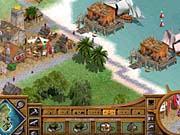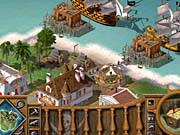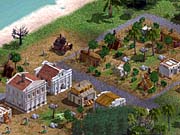Tropico 2: Pirate Cove Preview
We take a close look at Tropico's sequel, which moves back a few centuries to put you in control of a pirate island.
Pirates aren't exactly loveable, but we've seen enough heroics and humor in games and movies featuring eye-patch-wearing sailors that many of us have a soft spot for them. It's somewhat surprising, then, that there haven't been many pirate games--Sid Meier's Pirates, LucasArts' Monkey Island series, and Akella's Sea Dogs come to mind--and very few of them have combined that offbeat brand of pirate humor with serious gameplay. It's a tricky path to tread, but the designers at Frog City have had PopTop's excellent Tropico--which itself treated a serious political subject with a light touch--to serve as a model for its own upcoming game, Tropico 2: Pirate Cove.

Tropico 2 borrows only a few basic elements from its predecessor and is basically a brand-new game. Apart from the tropical Caribbean setting, the new game borrows from some of Tropico's basic game mechanics and its interface. Drawing parallels between the two games isn't enough to explain Tropico 2, but there are some easy parallels. Instead of a dictator of a 20th-century banana republic, in Tropico 2 you play as a pirate king. As leader of the pirate island, it's your responsibility to keep the pirates happy, the captive laborers fearful, and the plundered treasure pouring into the island's coffers.
The career of the pirate king is elaborated over the course of a 15-mission campaign. The first 10 missions are intended to teach you increasingly more about the game, and the last five are challenges that open up most of the buildings and game options and are intended to be a truer test of skill and strategy. The campaign starts out in the middle of the 17th century and ends in the early part of the 18th, so there's no mystery as to Tropico 2's time and place, but the game turns to both popular myth and history for its pirate flavor. There are plenty of opportunities to lure famous names like Blackbeard and Henry Morgan to the island to captain your ships and prove their unsavory reputations.
Nobody would expect pirates to be nice, and they're not. The pirate island's economy is entirely based on the money that comes in from robbing ships. Build a dock or two, equip a ship with cannons, and load it with crew and a captain and you'll then be ready to take a piece of the Caribbean riches. While you don't manually control ships in combat, there is some strategy involved in picking missions for your pirate ships, outfitting six types of ships, and choosing specific battle tactics--like staying back to pound opposing ships with cannons or rushing in to board.

Most of the looting takes place on a strategic map that divides the Caribbean into regions and lets you give orders to ships as they set sail. As a scenario progresses, the map may fill in with the locations of prime trade routes, but a dedicated exploration mission can take care of that more quickly. Likewise, each successful cruise will bring back a gaggle of captives to work in the shops and fields, but some shops require specialists that can be had quicker by sending out a kidnapping mission. The game is designed to bring high rewards for high risk, and an aggressive player could see all of an island's pirates living in mansions not all that long into a scenario. There are three nations to prey on and negotiate with--Spain, England, and France--and careful mission selection and some diplomacy can lead to official privateer status, which is one way to win a mission.
To keep the gold flowing in and keep a lid on revolt, you'll have to keep your island's population in check. The pirates live a life of comparative luxury, and any respectable pirate cove will have a good entertainment district to meet their needs. As in Tropico or even The Sims, each pirate has a series of bars that track their desires in categories such as food, rest, gambling, and "wenching." R and R takes place in a number of buildings that are purchased and built, and most entertainment structures come in low-, middle-, and high-rent versions that cater to different pirate demographics, as some will have more money in their pockets than others. If a pirate ever gets extremely dissatisfied, he's likely to draw his cutlass and take it out on the nearest passerby--and if he lives, the experience may just put him back in a good mood.
The better your pirates are, the better they'll fare at sea. As men fighting for pay, they're pretty cowardly when the odds are even. But there are ways to make sure the odds are in your favor, as an effective fighting force is backed up by a diverse island economy that is run entirely by captured labors. In addition to the entertainment district, there are plenty of buildings that produce only pirate possessions, from cannons to a swashbuckler's best friend, the parrot. To keep things interesting without excessive complexity, most raw materials have a few different uses. Iron, for example, can be cast into a cannon if you also have wood, or it can be forged into swords with the help of a captured specialist. Some buildings, such as the parrot aviary, require rare specialists.

Compared with the original game, Tropico 2 takes some of the micromanagement out of the economy by doing away with independent teamsters. Each building that needs supplies from somewhere else on the island has its own hauler employee to take care of it. And captives' movement around the map is greatly simplified by the fact that they prefer to walk along roads and will stick to the trails you set out.
That doesn't mean you can just forget about the forced labor that keeps the island running, though. Captives have feelings too, and the game tracks them in some detail. Basically, the game is balanced by two opposite preferences. The pirates prefer areas with a high anarchy rating, and captives will remain more peaceful if they spend most of their time in an area with a high order rating. While pirates stick to themselves, captives have to travel into the anarchic districts to provide the island's services, which would be a problem if there weren't two other ways to keep them in their place: awe and fear.
Any inhabitant who's strongly in awe or in fear of the pirate king is unlikely to grumble too loudly, and fortunately there are lots of things to build to induce either awe or fear. Trappings of an oppressive regime--scaffolds hanging with skeletons, inquisitor's chambers, forts--work to create fear, while impressive buildings, including churches, work in the awe direction. But trappings aren't enough to stave off a reputation for weakness if captives successfully escape, and conversely, the fear factor will generally increase after successfully hunting down any escaping captive before he reaches shore. To make it easy to keep track of your island's economy and its inhabitants, there's an incredibly detailed almanac view for statistics. A nice feature of the almanac is that most categories have intuitive links to even more-detailed views of the population's subgroups.
There seems to be plenty of depth to the gameplay, and once you've learned some skills in the campaign, there are more scenarios to keep busy with. Custom scenarios played on random maps were Tropico's bread and butter, and free-form play will be back with a vengeance in the sequel. To start a sandbox game, you can pick from a number of established pirate king profiles or customize your own, picking a background, two qualities (such as inquisitor, dreadful notoriety, or voodoo adept), and one flaw. In addition to the free-form missions, there'll be a number of stand-alone scenarios with a brief story and interesting mission objectives. It's unsure exactly how many will be included in the final game--Frog City's lead designer Bill Spieth pegged the current number at eight, but there may be more.

As for visuals, Tropico 2 completely converts the original game's graphics to the new setting, but it basically uses the same engine. The game has plenty of conventional pirate imagery, but a fair bit of originality seems to have gone into its presentation. The in-game graphics seem to have the same high level of detail as Tropico's, and humorous animations and Easter eggs are hidden here and there. We didn't hear too much of the audio, but fortunately, it doesn't seem overloaded with clichéd audio clips of pirates shouting, "Yar, matey!"
Take-Two has been very quiet about Tropico 2 since its announcement early last year. The good news is that we recently had an opportunity to see the game now that it's at the alpha milestone, and it seems to be in good shape. Before the game hits beta, the team has a few tasks on its plate, like cleaning up the visuals, adding more content to the in-game encyclopedia, and fine-tuning the game balance. The game has been in development at Frog City since late 2001, while PopTop has been busy at work on Railroad Tycoon III. But the original game's creators have had some input and applied their talents to some specific areas, creating, for example, the new game's cinematics. Tropico 2 is now in the final stretch, and it's on track for release in April.
Got a news tip or want to contact us directly? Email news@gamespot.com
Join the conversation